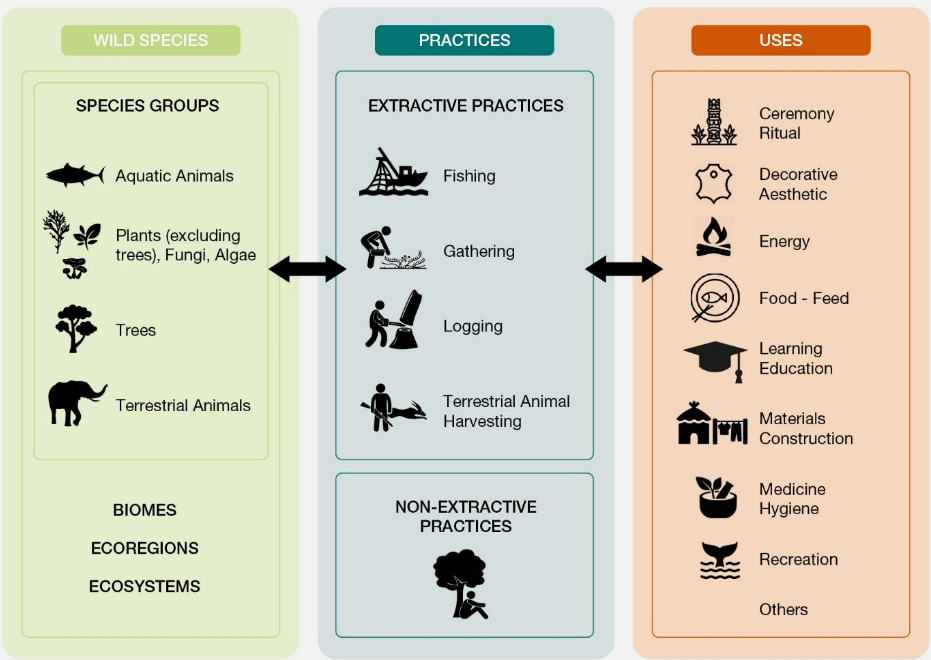Biodiversity & Environment
Sustainable Use of Wild Species: IPBES Report
- 09 Jul 2022
- 7 min read
For Prelims: IPBES
For Mains: Sustainable Use of Wild Species
Why in News?
A report released by the Intergovernmental Science-Policy Platform on Biodiversity and Ecosystem Services (IPBES) has stated that Sustainable use of wild species can meet needs of billions.
- Delegates from 140 countries came together to discuss and reach an outcome on the sustainable use of wildlife.
- The assessment shortlisted five categories of practices used for wild species — Fishing, Gathering, Logging, Terrestrial animal harvesting which includes hunting and non-extractive practices such as observing.
- The report is the first of its kind and has been conceived after a period of four years.
What is IBPES?
- It is an independent intergovernmental body, established by member States in 2012.
- It strengthens the science-policy interface for biodiversity and ecosystem services for the conservation and sustainable use of biodiversity, long-term human well-being and sustainable development.
What are the Findings?
- Dependence on Wild Species:
- About 70% of the world’s poor population is directly dependent on wild species.
- 20% source their food from wild plants, algae and fungi.
- About 70% of the world’s poor population is directly dependent on wild species.
- Wild-Species-Important Source of Income
- The use of wild species is an important source of income for millions of people worldwide.
- Wild tree species account for two thirds of global industrial roundwood, trade in wild plants, algae and fungi is a billion-dollar industry, and even non-extractive uses of wild species are big business.
- Local Variations:
- About 34% of marine wild fish stocks are overfished and 66% are fished within biologically sustainable levels. But within this global picture, there are significant local and contextual variations.
- Unsustainable Logging of Tree Species:
- The survival of an estimated 12% of wild tree species is threatened by unsustainable logging.
- Unsustainable gathering is one of the main threats for several plant groups, notably cacti, cycads and orchids.
- Unsustainable hunting has been identified as a threat for 1,341 wild mammal species – with declines in large-bodied species that have low natural rates of increase also linked to hunting pressure.
- Rural People are at Risk of Unsustainable Use:
- Rural people in developing countries are most at risk from unsustainable use of Wild Species, with lack of complementary alternatives often forcing them to exploit wild species already at risk.
- About 50,000 wild species are used through different practices, including more than 10,000 wild species harvested directly for human food.
- Rural people in developing countries are most at risk from unsustainable use of Wild Species, with lack of complementary alternatives often forcing them to exploit wild species already at risk.
- Cultural Significance leading to Exploitation:
- Certain species have cultural importance as they offer multiple benefits that define tangible and intangible features of people’s cultural heritage.
- The use of wild species is also a source of culturally meaningful employment for such communities and they have engaged in the trade of wild species and materials since millennia.
- Wild rice (Zizania palustris L.) is a cultural keystone species, providing physical, spiritual and cultural sustenance for many indigenous peoples in the Great Lakes region of North Americ
- Drivers and Threats:
- Drivers such as land- and seascape changes, climate change, pollution and invasive alien species that impact the abundance and distribution of wild species, and can increase stress and challenges among the human communities that use them.
- Illegal Trade:
- Global trade in wild species has expanded substantially in volume, value and trade networks over the past four decades.
- Illegal trade in wild species represents the third largest class of all illegal trade – with estimated annual values of up to USD199 billion. Timber and fish make up the largest volumes and value of illegal trade in wild species.
What are the Recommendations?
- Integration of diverse value systems, equitable distribution of costs and benefits, changes in cultural norms and social values and effective institutions and governance systems can facilitate the sustainable use of wild species in future.
- Addressing the causes of unsustainable use and, wherever possible reversing these trends, will result in better outcomes for wild species and the people who depend on them.
- Bringing scientists and indigenous peoples together to learn from each other will strengthen the sustainable use of wild species.
- This is especially important because most national frameworks and international agreements largely continue to emphasize ecological and some social considerations, including economic and governance issues – while cultural contexts receive little attention.
- In fishing, fixing current inefficiencies, reducing illegal, unreported and unregulated fishing, suppressing harmful financial subsidies, supporting small-scale fisheries, adapting to changes in oceanic productivity due to climate change, and proactively creating effective transboundary institutions will help sustainable Use.
- Countries with robust fisheries management had seen stocks increasing in abundance. The Atlantic bluefin tuna population, for instance, has been rebuilt and is now fished within sustainable levels.
- In logging this would entail management and certification of forests for multiple uses, technological innovations to reduce waste in manufacturing of wood products, and economic and political initiatives that recognize the rights of indigenous peoples and local communities, including land tenure.





